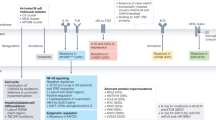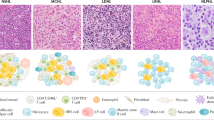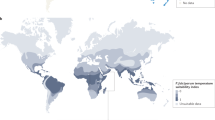Abstract
Non-Hodgkin's lymphoma invades the brain, the vitreous body and nerves of the eye, the meninges, and the nerve roots of brain and spine, leading to the development of a primary CNS lymphoma. The mechanism of involvement of these locations by malignant B lymphocytes is unknown, but it might involve molecular targeting of lymphoma cells generated at cryptic systemic sites. The diagnosis of primary CNS lymphoma has been facilitated by advances in imaging techniques and the discovery of molecular markers. Methotrexate-based regimens, even when radiation is deferred, prolong overall survival to over 5 years, but relapses eventually occur in most cases. Better tools for earlier diagnosis and monitoring of treatment response will emerge from molecular studies of therapeutic targets.
Key Points
-
Primary CNS lymphoma (PCNSL) is a nervous-system-seeking extranodal non-Hodgkin's lymphoma that shares common morphologic and molecular features with diffuse large B-cell lymphoma
-
Lymphomagenesis is probably promoted through direct transforming properties of infectious agents (Epstein–Barr virus in immunocompromised patients) or sustained antigenic stimulation by infection or autoimmune disease
-
PCNSL presents with syndromes ranging from language deficits, paresis of extremities, brain swelling, brainstem dysfunction, endocrine dysregulation and behavioral abnormalities to peripheral neuropathies and signs of vitreous disease
-
Diagnosis of PCNSL requires histopathological confirmation; clonality assessment by immunoglobulin gene rearrangement analysis or flow cytometry might prove useful not only for initial diagnosis but also for detection of minimal residual disease
-
High-dose methotrexate is an essential component of any treatment regimen for PCNSL
This is a preview of subscription content, access via your institution
Access options
Subscribe to this journal
Receive 12 print issues and online access
$209.00 per year
only $17.42 per issue
Buy this article
- Purchase on Springer Link
- Instant access to full article PDF
Prices may be subject to local taxes which are calculated during checkout




Similar content being viewed by others
References
Central Brain Tumor Registry of the United States (2005) Statistical Report: Primary Brain Tumors in the United States 1998–2002 (Years Data Collected). [http://www.cbtrus.org/reports//2005-2006/2006report.pdf]
Jemal A et al. (2006) Cancer statistics, 2006. CA Cancer J Clin 56: 106–130
Olson JE et al. (2002) The continuing increase in the incidence of primary central nervous system non-Hodgkin lymphoma: a surveillance, epidemiology, and end results analysis. Cancer 95: 1504–1510
Cingolani A et al. (2000) Epstein–Barr virus infection is predictive of CNS involvement in systemic AIDS-related non-Hodgkin's lymphomas. J Clin Oncol 18: 3325–3330
Sacktor N et al. (2001) HIV-associated neurologic disease incidence changes: Multicenter AIDS Cohort Study, 1990–1998. Neurology 56: 257–260
Bower M et al. (2006) Highly active antiretroviral therapy and human immunodeficiency virus-associated primary cerebral lymphoma. J Natl Cancer Inst 98: 1088–1091
Filipovich AH et al. (1987) The Immunodeficiency Cancer Registry: a research resource. Am J Pediatr Hematol Oncol 9: 183–184
Castellano-Sanchez AA et al. (2004) Primary central nervous system posttransplant lymphoproliferative disorders. Am J Clin Pathol 121: 246–253
Leblond V et al. (1998) Posttransplant lymphoproliferative disorders not associated with Epstein–Barr virus: a distinct entity? J Clin Oncol 16: 2052–2059
Alderson L et al. (1996) Sentinel lesions of primary CNS lymphoma. J Neurol Neurosurg Psychiatry 60: 102–105
Drillenburg P and Pals ST (2000) Cell adhesion receptors in lymphoma dissemination. Blood 95: 1900–1910
Springer TA (1994) Traffic signals for lymphocyte recirculation and leukocyte emigration: the multistep paradigm. Cell 76: 301–314
Smith JR et al. (2003) Expression of B-cell-attracting chemokine 1 (CXCL13) by malignant lymphocytes and vascular endothelium in primary central nervous system lymphoma. Blood 101: 815–821
Bashir R et al. (1992) Expression of LFA-1/ICAM-1 in CNS lymphomas: possible mechanism for lymphoma homing into the brain. J Neurooncol 12: 103–110
Aho R et al. (1997) Binding of malignant lymphoid cells to the white matter of the human central nervous system: role of different CD44 isoforms, beta 1, beta 2 and beta 7 integrins, and L-selectin. J Neuropathol Exp Neurol 56: 557–568
Jahnke K et al. (2006) Detection of subclinical systemic disease in primary CNS lymphoma by polymerase chain reaction of the rearranged immunoglobulin heavy-chain genes. J Clin Oncol 24: 4754–4757
Larocca LM et al. (1998) The molecular and phenotypic profile of primary central nervous system lymphoma identifies distinct categories of the disease and is consistent with histogenetic derivation from germinal center-related B cells. Blood 92: 1011–1019
Montesinos-Rongen M et al. (1999) Primary central nervous system lymphomas are derived from germinal-center B cells and show a preferential usage of the V4-34 gene segment. Am J Pathol 155: 2077–2086
Thompsett AR et al. (1999) VH gene sequences from primary central nervous system lymphomas indicate derivation from highly mutated germinal center B cells with ongoing mutational activity. Blood 94: 1738–1746
Alizadeh AA et al. (2000) Distinct types of diffuse large B-cell lymphoma identified by gene expression profiling. Nature 403: 503–511
Rosenwald A et al. (2002) The use of molecular profiling to predict survival after chemotherapy for diffuse large-B-cell lymphoma. N Engl J Med 346: 1937–1947
Rubenstein JL et al. (2006) Gene expression and angiotropism in primary CNS lymphoma. Blood 107: 3716–3723
Pasqualucci L et al. (2001) Hypermutation of multiple proto-oncogenes in B-cell diffuse large-cell lymphomas. Nature 412: 341–346
Montesinos-Rongen M et al. (2004) Primary diffuse large B-cell lymphomas of the central nervous system are targeted by aberrant somatic hypermutation. Blood 103: 1869–1875
Papavasiliou FN and Schatz DG (2002) Somatic hypermutation of immunoglobulin genes: merging mechanisms for genetic diversity. Cell 109 (Suppl 1): S35–S44
Schwindt H et al. (2006) Chromosomal translocations fusing the BCL6 gene to different partner loci are recurrent in primary central nervous system lymphoma and may be associated with aberrant somatic hypermutation or defective class switch recombination. J Neuropathol Exp Neurol 65: 776–782
Weber T et al. (2000) Characteristic chromosomal imbalances in primary central nervous system lymphomas of the diffuse large B-cell type. Brain Pathol 10: 73–84
Jordanova ES et al. (2002) Hemizygous deletions in the HLA region account for loss of heterozygosity in the majority of diffuse large B-cell lymphomas of the testis and the central nervous system. Genes Chromosomes Cancer 35: 38–48
Hochberg FH et al. (1983) Central-nervous-system lymphoma related to Epstein–Barr virus. N Engl J Med 309: 745–748
Cleary ML et al. (1985) Individual tumors of multifocal EB virus-induced malignant lymphomas in tamarins arise from different B-cell clones. Science 228: 722–724
Ambinder RF (2000) Gammaherpesviruses and 'hit-and-run' oncogenesis. Am J Pathol 156: 1–3
Epeldegui M et al. (2007) Infection of human B cells with Epstein–Barr virus results in the expression of somatic hypermutation-inducing molecules and in the accrual of oncogene mutations. Mol Immunol 44: 934–942
Smedby KE et al. (2006) Autoimmune and chronic inflammatory disorders and risk of non-Hodgkin lymphoma by subtype. J Natl Cancer Inst 98: 51–60
Zintzaras E et al. (2005) The risk of lymphoma development in autoimmune diseases: a meta-analysis. Arch Intern Med 165: 2337–2344
Glass J et al. (1993) Intravascular lymphomatosis: a systemic disease with neurologic manifestations. Cancer 71: 3156–3164
Baehring JM et al. (2003) Neurolymphomatosis. Neuro-oncol 5: 104–115
Akpek EK et al. (1999) Intraocular–central nervous system lymphoma: clinical features, diagnosis, and outcomes. Ophthalmology 106: 1805–1810
Buhring U et al. (2001) MRI features of primary central nervous system lymphomas at presentation. Neurology 57: 393–396
Moffat BA et al. (2005) Functional diffusion map: a noninvasive MRI biomarker for early stratification of clinical brain tumor response. Proc Natl Acad Sci USA 102: 5524–5529
Macdonald DR et al. (1990) Response criteria for phase II studies of supratentorial malignant glioma. J Clin Oncol 8: 1277–1280
Jahnke K et al. (2006) International study on low-grade primary central nervous system lymphoma. Ann Neurol 59: 755–762
Gijtenbeek JM et al. (2001) Primary central nervous system T-cell lymphoma. Neurology 57: 716–718
Gleissner B et al. (2002) CSF evaluation in primary CNS lymphoma patients by PCR of the CDR III IgH genes. Neurology 58: 390–396
Baehring JM et al. (2005) Analysis of clonal immunoglobulin heavy chain rearrangements in ocular lymphoma. Cancer 104: 591–597
Baehring JM et al. (2006) Immunoglobulin gene rearrangement analysis in cerebrospinal fluid of patients with lymphoproliferative processes. J Neurol Sci 247: 208–216
Ivers LC et al. (2004) Predictive value of polymerase chain reaction of cerebrospinal fluid for detection of Epstein–Barr virus to establish the diagnosis of HIV-related primary central nervous system lymphoma. Clin Infect Dis 38: 1629–1632
Cingolani A et al. (1998) Minimally invasive diagnosis of acquired immunodeficiency syndrome-related primary central nervous system lymphoma. J Natl Cancer Inst 90: 364–369
Bataille B et al. (2000) Primary intracerebral malignant lymphoma: report of 248 cases. J Neurosurg 92: 261–266
Cher L et al. (1996) Therapy of primary CNS lymphoma with methotrexate-based chemotherapy and deferred radiotherapy: preliminary results. Neurology 46: 1757–1759
Batchelor T et al. (2003) Treatment of primary CNS lymphoma with methotrexate and deferred radiotherapy: a report of NABTT 96-07. J Clin Oncol 21: 1044–1049
Ferreri AJ et al. (2004) Area under the curve of methotrexate and creatinine clearance are outcome-determining factors in primary CNS lymphomas. Br J Cancer 90: 353–358
Doolittle ND et al. (2000) Safety and efficacy of a multicenter study using intraarterial chemotherapy in conjunction with osmotic opening of the blood–brain barrier for the treatment of patients with malignant brain tumors. Cancer 88: 637–647
DeAngelis LM et al. (2002) Combination chemotherapy and radiotherapy for primary central nervous system lymphoma: Radiation Therapy Oncology Group Study 93-10. J Clin Oncol 20: 4643–4648
Poortmans PM et al. (2003) High-dose methotrexate-based chemotherapy followed by consolidating radiotherapy in non-AIDS-related primary central nervous system lymphoma: European Organization for Research and Treatment of Cancer Lymphoma Group Phase II Trial 20962. J Clin Oncol 21: 4483–4488
Nelson DF et al. (1992) Non-Hodgkin's lymphoma of the brain: can high dose, large volume radiation therapy improve survival? Report on a prospective trial by the Radiation Therapy Oncology Group (RTOG): RTOG 8315. Int J Radiat Oncol Biol Phys 23: 9–17
Khan RB et al. (2002) Is intrathecal methotrexate necessary in the treatment of primary CNS lymphoma? J Neurooncol 58: 175–178
Plotkin SR et al. (2004) Treatment of relapsed central nervous system lymphoma with high-dose methotrexate. Clin Cancer Res 10: 5643–5646
Enting RH et al. (2004) Salvage therapy for primary CNS lymphoma with a combination of rituximab and temozolomide. Neurology 63: 901–903
Nguyen PL et al. (2005) Results of whole-brain radiation as salvage of methotrexate failure for immunocompetent patients with primary CNS lymphoma. J Clin Oncol 23: 1507–1513
Soussain C et al. (2001) Results of intensive chemotherapy followed by hematopoietic stem-cell rescue in 22 patients with refractory or recurrent primary CNS lymphoma or intraocular lymphoma. J Clin Oncol 19: 742–749
Abrey LE et al. (2003) Intensive methotrexate and cytarabine followed by high-dose chemotherapy with autologous stem-cell rescue in patients with newly diagnosed primary CNS lymphoma: an intent-to-treat analysis. J Clin Oncol 21: 4151–4156
Forsyth PA et al. (1994) Combined-modality therapy in the treatment of primary central nervous system lymphoma in AIDS. Neurology 44: 1473–1479
Newell ME et al. (2004) Human immunodeficiency virus-related primary central nervous system lymphoma: factors influencing survival in 111 patients. Cancer 100: 2627–2636
Roychowdhury S et al. (2003) Experimental treatment of Epstein–Barr virus-associated primary central nervous system lymphoma. Cancer Res 63: 965–971
Batchelor TT et al. (2003) High-dose methotrexate for intraocular lymphoma. Clin Cancer Res 9: 711–715
Smith JR et al. (2002) Role of intravitreal methotrexate in the management of primary central nervous system lymphoma with ocular involvement. Ophthalmology 109: 1709–1716
Fliessbach K et al. (2003) Cognitive performance and magnetic resonance imaging findings after high-dose systemic and intraventricular chemotherapy for primary central nervous system lymphoma. Arch Neurol 60: 563–568
Omuro AM et al. (2005) Delayed neurotoxicity in primary central nervous system lymphoma. Arch Neurol 62: 1595–1600
Correa DD et al. (2004) Cognitive functions in survivors of primary central nervous system lymphoma. Neurology 62: 548–555
Harder H et al. (2004) Cognitive status and quality of life after treatment for primary CNS lymphoma. Neurology 62: 544–547
Neuro-oncological Working Group of the German Cancer Society [German] [http://www.neuroonkologie.de]
Phase IV study on the role of whole-brain radiation in the primary therapy of primary CNS lymphoma with high-dose methotrexate [German] [http://www.charite.de/haema-cbf/pcnsl.htm]
Issa S et al. (2006) Treatment of primary CNS lymphoma with induction high-dose methotrexate, temozolomide, rituximab followed by consolidation cytarabine/etoposide: a pilot study with biomarker analysis [abstract]. J Clin Oncol 24 (Suppl): A7595
Radiation Therapy Oncology Group [http://www.rtog.org]
ClinicalTrials.gov [http://clinicaltrials.gov]
Memorial Sloan–Kettering Cancer Center, New York [http://www.mskcc.org]
Oregon Health & Science University [http://www.ohsu.edu]
Eastern Cooperative Oncology Group [http://www.ecog.org]
International Extranodal Lymphoma Study Group [http://www.ielsg.org]
National Cancer Institute Clinical Trials [http://www.cancer.gov/clinicaltrials]
Panageas KS et al. (2005) Trends in survival from primary central nervous system lymphoma, 1975–1999: a population-based analysis. Cancer 104: 2466–2472
Abrey LE et al. (2000) Treatment for primary CNS lymphoma: the next step. J Clin Oncol 18: 3144–3150
McAllister LD et al. (2000) Cognitive outcomes and long-term follow-up results after enhanced chemotherapy delivery for primary central nervous system lymphoma. Neurosurgery 46: 51–60
Pels H et al. (2003) Primary central nervous system lymphoma: results of a pilot and phase II study of systemic and intraventricular chemotherapy with deferred radiotherapy. J Clin Oncol 21: 4489–4495
Abrey LE et al. (2005) Report of an international workshop to standardize baseline evaluation and response criteria for primary CNS lymphoma. J Clin Oncol 23: 5034–5043
Author information
Authors and Affiliations
Corresponding author
Ethics declarations
Competing interests
The authors declare no competing financial interests.
Rights and permissions
About this article
Cite this article
Hochberg, F., Baehring, J. & Hochberg, E. Primary CNS lymphoma. Nat Rev Neurol 3, 24–35 (2007). https://doi.org/10.1038/ncpneuro0395
Received:
Accepted:
Issue Date:
DOI: https://doi.org/10.1038/ncpneuro0395
This article is cited by
-
Efficacy of endoscopic management of primary central nervous system lymphoma: a multicentric study and literature review
Journal of Neuro-Oncology (2022)
-
Autoimmune disease-related primary CNS lymphoma: systematic review and meta-analysis
Journal of Neuro-Oncology (2020)
-
Imaging features (CT, MRI, MRS, and PET/CT) of primary central nervous system lymphoma in immunocompetent patients
Neurological Sciences (2019)
-
Prognostic markers for immunodeficiency-associated primary central nervous system lymphoma
Journal of Neuro-Oncology (2019)
-
Association between ocular findings and preventive therapy with onset of central nervous system involvement in patients with primary vitreoretinal lymphoma
Graefe's Archive for Clinical and Experimental Ophthalmology (2014)



